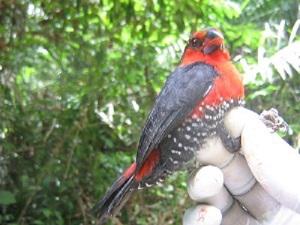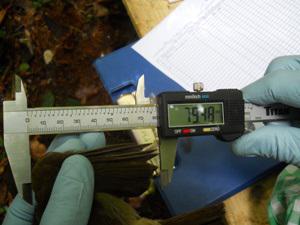Jean Bernard Dongmo
This project aims to assess the taxonomic status of avian species that are found on both sides of the Dahomey Gap in West Africa. Isolated populations on either side of the gap may be deeply divergent genetically over several million of years, and likely represent distinct species worthy of conservation.

Western Bluebill (Spermophaga haematina).
Geographic isolation is a general process leading to species formation. In West Africa, the Guinean-Congolian forest is physically divided into two main parts by a large savannah strip called the “Dahomey-Gap”. Whereas many studies have focused on the effects of Pleistocene climate change and forest refugia on speciation in the Amazon and Australian wet tropics, data on African tropical forest taxa remain sparse. A recent phylogenetic analysis of wattle-eyes suggests that chestnut wattle-eye (Platysteira castanea) populations in Ghana and Cameroon are highly divergent genetically, and have evolved in isolation for at least several million years (Njabo, 2008, Mol. Phylog. & Evol.). No previous study has attempted a survey of population samples of species found in both upper and lower Guinea forests, but not within the Dahomay gap. The present study intends to test evolutionary divergence in five passerine birds (Andropadus latirostris, Hylia prasina, Spermophaga haematinae, Cisticola galactotes and Euplectes afer).

Measurement of an Andropadus latirostris’s wing length. © Jean Bernard.
Genetic samples and morphological data will be collected at two rain forest refugia in Cameroon (completed in 2009) and Ghana (to be carried out in the frame of the present RSG award). Genomic DNA will be extracted from genetic samples. Portions of the mitochondrial DNA and several nuclear loci will be sequenced using standard methods. Genetic data will be used in phylogenetic and coalescent analyses to test whether population divergence times are similar across species and whether populations of any of these species are connected by ongoing gene flow.
This research will contribute both to our understanding of the evolutionary mechanisms involved in speciation and the potential role of the Dahomey Gap in driving species divergence and generating biodiversity. The upper and lower Guinea forests are counted among the hot-spots of global biodiversity, each containing a large number of threatened and endangered species. Unfortunately, we still do not have a full understanding of the taxonomic diversity in these forests, even for well-studied groups like birds. To the extent that my research reveals ancient divergence between populations and previously unrecognized biodiversity, it will provide a stronger rationale for conserving both the unique forms in different regions as well as the regional ecological and evolutionary processes that helped generate that biodiversity in the first place.